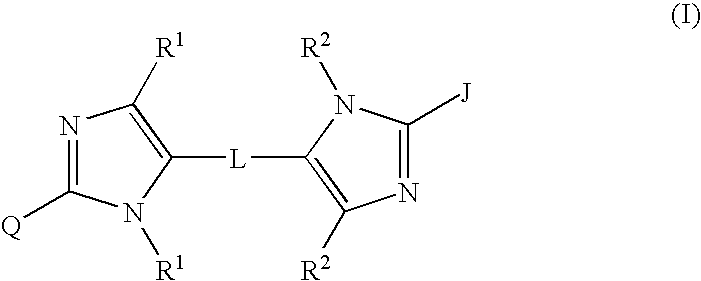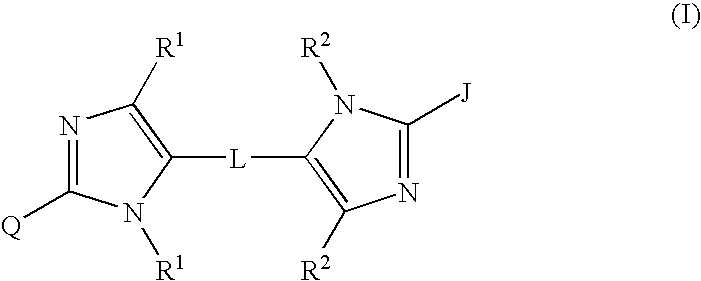Linked diimidazole antivirals
a diimidazole and antiviral technology, applied in the field of new antiviral agents, can solve the problems of hcv genotype, less effective therapy against infections, and unlikely development of a vaccine in the near futur
- Summary
- Abstract
- Description
- Claims
- Application Information
AI Technical Summary
Benefits of technology
Problems solved by technology
Method used
Image
Examples
example 1
[0186]
Step 1a. A solution of bromine (1.23 ml, 23.97 mmol) in glacier acetic acid (6 ml) was added dropwise into a suspension of 2,7-diacetylfluorene (3.0 g, 11.99 mmol) in glacier acetic acid (50 ml) at 50° C. Upon completion of the addition, heating was stopped and the mixture was stirred at rt for 24 hr. More bromine (0.31 ml, 6.05 mmol) in glacier acetic acid (1 ml) was added. The mixture was stirred at rt for another 20 hr before being filtered to afford the crude desired dibromide as a yellow solid (5.413 g).
Step 1b. A suspension of the crude compound from step 1a (5.413 g, 11.99 mmol at most) was treated with N-Boc-L-proline (5.161 g, 23.98 mmol) in CH3CN (100 ml) in the presence of TEA (6.85 mL, 49.16 mmol). The resulting suspension was stirred at rt overnight. The volatiles were evaporated off and the residue was partitioned between CH2Cl2 and H2O. The aqueous layer was extracted with CH2Cl2. The combined organics were dried (Na2SO4), filtered and evaporated. The residue wa...
example 2
[0187]
Step 1d. A solution of the compound from step 1c (81.0 mg, 0.127 mmol) in CH2Cl2 (5 mL) was treated with HCl in 1,4-dioxane (4 M, 10 mL) at rt for 30 minutes. The volatiles were evaporated off to give the crude desired compound as a yellow solid which was directly used in the next step.
Step 1e. A mixture of the crude compound from step 1d (0.127 mmol at most) and (R)—N,N-dimethylamino phenyl acetic acid (prepared according to WO 2008 / 021927, 56.9 mg, 0.317 mmol) in DMF (3 mL) was treated with HATU (0.106 g, 0.279 mmol) in the presence of DIPEA (0.44 mL, 2.54 mmol) for 2 hours at rt and the volatiles were evaporated off to provide a brown syrup. It was purified by reverse phase HPLC (C18, H2O / CH3CN / TFA) to give the title compound as its TFA salts and as a yellow solid (0.071 g, 2 steps 46%). ESIMS m / z=759.43 [M+H]+.
example 1-a
[0188]
Step 1f. To a solution of (S)-proline aldehyde (5.00 g, 25.09 mmol) in 7 N ammonia in methanol (100 mL) at 0° C. was added glyoxal (40% in water, 10 mL) slowly. After the addition, the mixture was allowed to warm to rt gradually and stirred at rt for 24 hr. The volatiles were evaporated off. The residue was partitioned between CH2Cl2 and H2O. The aqueous layer was extracted with EtOAc. The combined organic layers were washed with brine, dried (Na2SO4), filtered and evaporated. The residue was purified by flash column chromatography (silica, ethyl acetate with 1% Et3N) to give the desired compound as a slightly yellow solid (2.50, 42%). ESIMS m / z=238.20 [M+H]+.
Step 1g. A solution of the compound from step 1f (3.56 g, 15.00 mmol) in ethanol (350 mL) was treated with 2,4,4,6-tetrabromo-2,5-cyclohexadienone (90%, 17.07 g, 37.50 mmol) at rt. The mixture was stirred at rt for 24 hr before being concentrated. The residue was partitioned between EtOAc (with 1% Et3N) and aqueous NaHCO3...
PUM
| Property | Measurement | Unit |
|---|---|---|
| body weight | aaaaa | aaaaa |
| body weight | aaaaa | aaaaa |
| min-width | aaaaa | aaaaa |
Abstract
Description
Claims
Application Information
 Login to View More
Login to View More - R&D
- Intellectual Property
- Life Sciences
- Materials
- Tech Scout
- Unparalleled Data Quality
- Higher Quality Content
- 60% Fewer Hallucinations
Browse by: Latest US Patents, China's latest patents, Technical Efficacy Thesaurus, Application Domain, Technology Topic, Popular Technical Reports.
© 2025 PatSnap. All rights reserved.Legal|Privacy policy|Modern Slavery Act Transparency Statement|Sitemap|About US| Contact US: help@patsnap.com



